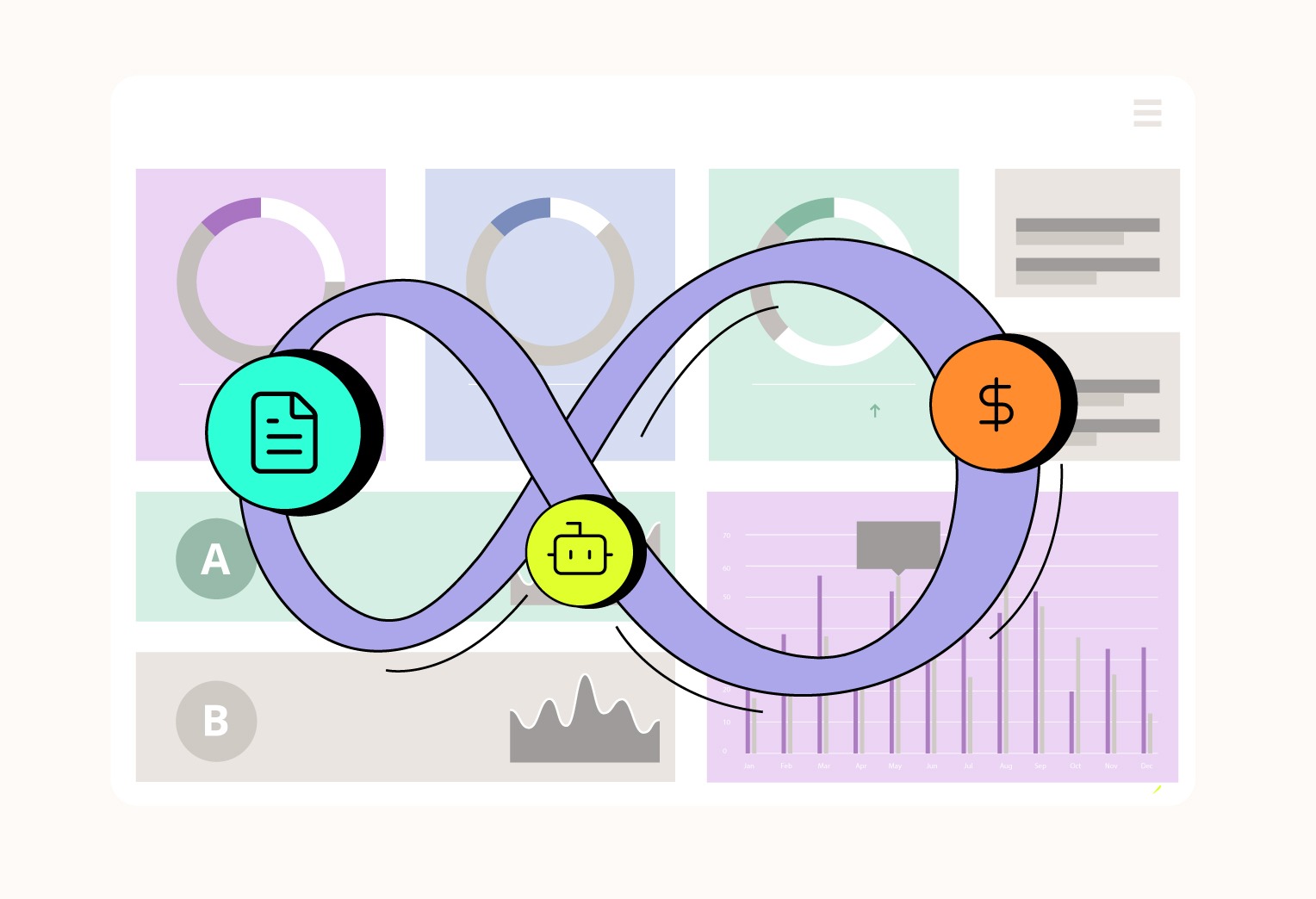Almost all of the teams within your finance function operate with their inventory of tools. These tools don’t talk to each other, creating pockets of data. Nevertheless, even when all are digitalized, they still come with manual handshakes. This brings the need for connected finance.
Connected finance is the process within finance operations that unifies interconnected processes into a workflow. It offers greater control, improves productivity, and promises better outcomes to finance teams.
This blog discusses the concept of connected finance, its value, and its key components. Let's immerse through.
The fundamental bricks of connected finance
Connected finance can be defined as integrating financial systems, processes, and data through technology. It brings together multiple business platforms, data sources, and aggregating systems to achieve a unified business outcome.
Connected finance leverages the latest technologies across RPA, AI/ML, and advanced data analytics to streamline financial operations and improve operational excellence.
Consider this scenario - with connected finance, your accounting software and CRM could talk to each other and drive business growth together. That means your data flows across all your critical business applications seamlessly. This also helps you eliminate errors and build org-wide clarity across business-critical metrics.
The benefits you get from connected finance
#1 Holistic visibility
Connected finance gives CFOs a real-time view of their company's financial performance. This allows them to identify trends, spot anomalies, and make quality decisions. For example, a CFO can use connected finance to see how a new product launch affects sales or identify areas where costs can be reduced.
#2 Improved efficiency
Connected finance increases CRM and ERP efficiencies by bringing operational platforms closer to financial functions. It ties data from business systems within the systems of record, offering industry specific KPIs and metrics.
#3 Enhanced collaboration
Unified financial data helps with internal team collaboration. It also bolsters your partnerships with vendors, promoting real teamwork. Moreover, collaborative decision-making positively impacts the cash flow of a business.
#4 Dynamic decision-making
Connected finance furnishes CFOs with a finger-tap of real-time data. It opens the possibility of stitched data and assists businesses with decisions like new revenue streams, market entry choices, and new processes.
#5 Reduced risk and fraud
Connected finance can help CFOs to identify and mitigate risks more effectively. For example, a CFO can use connected finance to monitor for fraudulent transactions or to identify areas where the company is exposed to financial risk.
How do technology and automation enable connected finance?
Change-ready finance functions are already adopting connected finance. The following cutting-edge technologies propel connected finance.
- Integration: Technology connects different financial systems and platforms, enabling seamless data flow and integrated workflows. The pulling of business data from multiple systems is enabled through powerful APIs. This allows financial institutions and individuals to have a holistic view of their financial health and make informed decisions.
- Automation: Automation streamlines and automates repetitive and time-consuming tasks, such as data entry, reconciliation, and payment processing. This frees up financial professionals to focus on more strategic and value-added activities.
- Real-time insights: Technology enables real-time data analytics and insights, providing financial institutions and individuals with up-to-date information on their financial performance and market trends. This helps them make better decisions faster.

How does breaking down silos propel connected finance?
F&A teams are fragmented. In that, they use different supporting tools and technologies. They are often focused on their own goals rather than driving the overarching goal of the business.
For instance, one may witness record-to-analyze (R2A) teams buckling down to gain visibility into the data generated by order-to-cash (O2C) teams. Each uses specialized tools and platforms, further creating data silos.
The absence of a single source of truth limits decision-making and collaboration. So, how to eliminate the data, operational, and process silos within finance departments? This question lingers in every modern CFO's mind.
The ultimate solution is to combine people, processes, and technology. You can do three things here:
- Create shared goals across teams and adopt collaboration tools.
- Utilize finance observability platforms that integrate with all financial systems.
- Make data generated from finance visible to all.
Connected finance cements CIO-CFO partnership
Implementing connected finance through finance observability platforms helps strengthen the bond between the CFO and CIO. Both leaders can benefit from digitally transformed financial operations. With real-time data, they can align on the same goal and plan.
For instance, consider joint budgeting and forecasting. CFOs and CIOs can collaborate using connected finance to create and oversee budgets and forecasts together. This ensures that the IT investments are in line with the company's overall business objectives and that the IT department is functioning within its financial limits.
[Example] Clear & connected finance in action
Clear provides real-time data for efficient tax filing by directly incorporating invoice and e-invoice data into draft GST returns. It helps generate e-way bills without manual data entry. Also, it supports automated and real-time reconciliations, meaning enterprises can know at any time—
- If their data does not match
- Whether their suppliers are defaulting
- Whether they are at risk of paying penalties
Furthermore, Clear puts various finance processes on auto-pilot. It automates processes across accounts payable, vendor risk management, tax, compliance, invoice discounting, and financing.
Clear achieved the following from connected finance:
- Increased efficiency and productivity: Clear's Connected Finance ecosystem automates critical finance processes, such as invoice processing, tax compliance, and reporting. This frees up finance teams to focus on more strategic initiatives.
- Reduced costs: Clear's Connected Finance ecosystem helps businesses to reduce costs in several ways, such as automating manual tasks, reducing errors, and improving cash flow management.
- Improved compliance: Clear's Connected Finance ecosystem helps businesses stay compliant with complex tax and regulatory requirements.
- Increased visibility and control: Clear's Connected Finance ecosystem provides businesses with real-time visibility into their financial performance. This helps businesses to make better decisions and improve their overall bottom line.
ROI and metrics
Clear's Connected Finance ecosystem has helped businesses achieve significant ROI. For example, one customer reported a 20% reduction in invoice processing time and a 5% reduction in tax compliance costs. Another customer reported a 10% improvement in cash flow management.
Final ideas
Connected finance can help you to improve your decision-making, increase efficiency, and reduce risk. They enable digital handshakes and weave together a web of disjointed solutions.
Here are some tips for implementing connected finance in your organization:
Tip 1 Start with a clear plan and goal.
What are you hoping to achieve by implementing the practice?
Tip 2 Choose the right technology and partners.
There are several different connected finance solutions available. Choose a solution that meets your specific needs and budget.
Tip 3 Communicate the benefits to stakeholders.
Communicate the benefits of connected finance to all stakeholders, including employees, managers, and investors. This will ensure everyone is on board with the implementation process.
Tip 4 Provide training and support to users.
Offer training and support to users of the connected finance solution. This will help them to get the most out of the solution and to use it effectively.
And finally, if you are considering transforming your organization by implementing connected finance, you should give Bluecopa a try.
FAQs
1. What are the benefits of connected finance?
Connected finance offers several benefits, including:
- Improved financial visibility and insights
- Increased efficiency and productivity
- Enhanced collaboration and communication
- Reduced risk and fraud
2. What are the challenges of implementing connected finance?
Some of the challenges of implementing connected finance include:
- Data silos and integration challenges: Integrating data from different systems is a challenging and time-consuming process.
- Lack of expertise and resources: Financial organizations often lack the expertise and resources to implement connected finance.
- Cultural resistance to change: When implementing connected finance, financial organizations may face cultural resistance to change due to the significant changes required in existing workflows and processes.
Looking to implement connected finance in your org? Let's have a sit-down and chat.




.jpg)